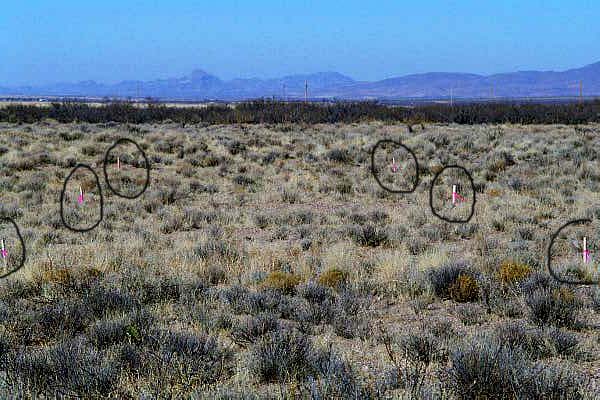
Out here, in what appears to the untrained eye to be the middle of nowhere, is the site selected for the great observatory project (the trained eye is rather more certain that it is the middle of nowhere :-). I've waited a lifetime for the opportunity to build a nice dark-sky observatory, and the time has finally come.
Under the dark, clear, steady skies of New Mexico, I'll be building a rolloff-roof observatory following the notion of Dave Kriege's article in the June, 1997, issue of Astronomy magazine ("Build a Backyard Observatory for Peanuts"). Circled in this photograph are the stakes that mark the observatory building proper and the area toward the background onto which the roof will roll.
This site is actually not in the middle of nowhere, but it is right next door to it, so it's not a place to go for a short evening of observing - longer stays will be a necessity. Since my idea of roughing it is a TV without a DVD player, it's obvious that I'm going to need water and electricity. And I've been an Internet citizen since back when it was still called ARPAnet, so I need a connection, and that means a telephone line.
All of this means that my observatory is somewhat more ambitious than the typical backyard installation. This facility will include an offset basement that will serve as a living quarters; the major advantages of this are (1) it will require little or no cooling in the 100-degree heat of the summertime desert, and (2) it will be pitch-dark even during the daytime, when I need to sleep!
I've drawn a floor plan of the observatory's observing level for planning purposes. There are two telescope piers with plenty of maneuvering room around them, and space to install cabinets and tables. As is usual in these designs, the roof rolls off to the north (to the left in the plan).
I drew a lot of inspiration from John A. McCubbin's Halfmoon Observatory; he built his building with a steel skeleton and steel siding, so the entire building cools down rapidly after sunset. His pier design, which is no longer illustrated on his site, was what I roughly copied for my own.
My main instrument will be a 400mmm (16") Astro Optik LOMO Hypergraph on an Astro-Physics 1200GTO German equatorial mount, whose main purpose will be film astrophotography. Check out this photograph, taken through a Hypergraph with a 6x7 camera, of the Lagoon Nebula. Note how small and round the stars are right out to the very corners of the image.
Having secured a suitable 40-acre parcel, where does one start? It turns out that the logical method of proceeding begins with drilling a well; that gives the electric company and the phone company an aiming point for their lines. So I found a well driller and we picked a spot near the middle of the 40 acres; he then commenced to drill.
Next up: The Well
Return to The Great Observatory Project
The TRF Housing Tract Home Page
Terry R. Friedrichsen
terry@mail.trf.sunquest.com